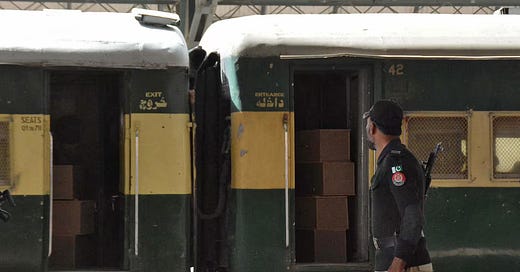From Quetta to Chaos: The Jaffar Express Hijacking and Pakistan's Security Dilemma
How a 30-hour standoff in Balochistan can reshape regional geopolitics.
Pakistan, often headlined for its Kashmir conflict with India, entanglements in Afghanistan, strategic alliance with China, or its status as a nuclear nation with a jihadist problem, was once again forced to confront an insurgency it has long sought to suppress - Balochistan.
The 30-hour-long hijacking of the Jaffar Express en route from Quetta to Peshawar on March 11 by the Baloch Liberation Army (BLA) cannot be seen in isolation; it was a demonstration of the outfit’s enhancing operational audacity and capacity. Armed insurgents halted the train inside the tunnel, slowing down any potential security response, and compelling forces into a bottleneck that restricted their movement. The tunnel also provided natural cover, further complicating aerial surveillance and strikes. BLA’s operational sophistication informs substantial training, more resources, and a refined ability to disrupt state control. This shift exemplifies BLA’s evolution beyond traditional rural insurgency involving hit-and-run anti-state attacks to coordinated urban plots targeting infrastructure, security forces, and migrant communities in the province.
At least 21 hostages and four security personnel were reportedly killed in the March 11 attack in Bolan district, a region long considered the BLA’s heartland. The militants intercepted the train in Bolan, where the late BLA commander Aslam Baloch, the mastermind behind the group’s modern strategy, established specialized units with designated missions. This attack holds significance not just for its scale but for its symbolism. The Jaffar Express has been targeted previously, most recently at Quetta Railway Station in November 2024. Bolan has been central to BLA’s insurgent planning, and the precision of the attack underscores its developing tactical coordination. Once a fractured insurgency, the BLA has expanded into a sophisticated unit capable of cross-factional cooperation with groups like the Majeed Brigade, known for its suicide operations, Fateh, a unit specializing in complex, high-risk missions, and STOS (Special Tactical Operations Squad), its intelligence wing.
Eye-witness accounts reveal that the attackers specifically segregated hostages based on their ethnic identities, executing Punjabi passengers - a politically and economically dominant group in Pakistan - while sparing Baloch civilians. These details, largely absent from Pakistan’s official accounts, reinforce that the attack was not a random incident but a calculated political statement. Baloch separatists have long accused the Punjabi-dominated state of exploiting their province’s resources without equitable redistribution. By claiming that women and children were deliberately targeted, Pakistan’s military seeks to erode any potential local support for the BLA while reinforcing its role as the nation’s protector against violent militants.
Image courtesy: Reuters
Pakistan’s Counterterrorism Rhetoric – Framing an External Enemy
Pakistan was quick to blame its neighbors for the attack, characterizing it as the work of foreign-backed insurgents. Local media cited security sources alleging that BLA operatives were in contact with "handlers" in Afghanistan during the attack. A senior official also implicated India, a typical pattern in Pakistan’s counterterrorism rhetoric. Nevertheless, evidence substantiating these claims remains negligible. The continued effort to internationalize the Baloch insurgency, framing it as an act of hostile foreign actors rather than a homegrown rebellion, serves Pakistan’s strategic interests. It is intended to deflect attention from the state's shortcomings in Balochistan, where deep-rooted grievances persist due to decades of economic marginalization, enforced disappearances, and heavy-handed military operations. By externalizing the insurgency, Pakistan can portray itself as a victim of cross-border destabilization rather than a state encountering regional dissent.
This also plays into Pakistan's effort to seek counterterrorism support from the US. A securitized narrative of foreign-funded insurgency can be used to justify future military operations and funding under counterterrorism initiatives. However, the combination of an escalating Baloch insurgency and an already-overstretched security apparatus will divert attention from other pertinent existential threats in the country.
Regional Repercussions
A stable Balochistan is critical to China’s Belt and Road Initiative (BRI) ambitions. Gwadar, the crown jewel of the China-Pakistan Economic Corridor (CPEC), is central to Beijing’s vision for regional connectivity and trade. BLA’s frequent attacks on infrastructure, transport, and highways signal that CPEC remains vulnerable, worsening apprehensions over Pakistan’s ability to safeguard Chinese investments. The more instability festers, the more frustration is bound to grow in Beijing, where officials have already voiced concerns over the security of their economic interests.
The attack and Pakistan’s immediate blaming of Afghanistan-based handlers is liable to exacerbate already-frail ties between the Taliban and Pakistan. Relations between the two have already plummeted over the issue of the disputed Durand Line and violence perpetrated by the Tehreek-e-Taliban Pakistan (TTP). The intensifying pressure from Pakistan on the Taliban will deepen mistrust. As precedent suggests, the Taliban will be reluctant to be seen as bending to Pakistan's demands, and may continue to ignore these accusations, or worse, further enable anti-Pakistan elements to flourish in its backyard.
For India, the Baloch insurgency presents a strategic prospect. By amplifying Pakistan’s internal security challenges, India can undercut Islamabad’s efforts to portray itself as an equal player in regional diplomacy. India has dismissed any narrative of parity with Pakistan, and underlining Balochistan’s insurgency allows it to reinforce the argument that while India is a rising global power with a seat at the table, Pakistan is struggling to contain its fractures. Additionally, shifting international attention from Kashmir to Pakistan’s internal turmoil serves India’s diplomatic interests, particularly in forums where Islamabad raises the Kashmir dispute.
Recommended Reading
For more insights into Pakistan’s insurgencies, security challenges, and geopolitical shifts, check out these related analyses -
Constraining the Pakistani Military-Jihadi Complex by Pranay Kotasthane
Cash-Strapped Pakistan Buying Chinese 5th-Gen Jets Will Only Enhance Insecurity in South Asia by Aishwaria Sonavane
Post-Afghanistan Realities: Pakistan’s Search for Purpose in Trump’s Strategic Calculus by Aishwaria Sonavane
Interpreting the recent Bangladesh-Pakistan thaw by Aishwaria Sonavane




